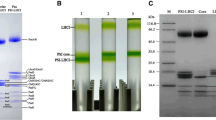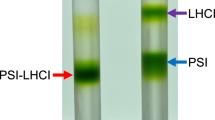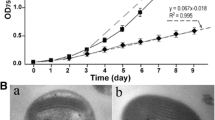Abstract
An active photosystem (PS) II particle and two light-harvesting complexes, as well as their sub-complexes that have not been reported previously, were isolated from a cryptophyte Chroomonas placoidea by Triton X-100 sucrose density gradient centrifugation. The fluorescence spectra revealed that there were efficient energy couplings between phycocyanin (PC645) and chlorophyll (Chl) within both zones III and IV of the gradient, which were designated respectively as light-harvesting complex and PSII particles whose size was 15–20 nm according to negative staining in electron microscopy. When the two complexes were further resolved into sub-complexes, the energy coupling was retained in the core PSI complex (named as zone IV-2 of the sucrose gradient), which contained almost no outer antenna pigment Chl c. Sodium dodecyl sulfate- polyacrylamide gel electrophoresis (SDS-PAGE) showed that the PC645 components appeared in Chl-containing protein complexes were mainly the β subunit with molecular weight of 20 kDa. These results demonstrate that PC645 in this cryptophyte was structurally but preferentially combined with the light-harvesting complex and PSII core. The excitation energy absorbed by PC645 could be directly transferred to Chl a (especially the long wavelength of Chl a) in the PSII reaction center or via the Chl a/c-protein complex. The β subunit corresponded to the terminal fluorescence emission and might play an important role in transmitting energy from PC645 to the Chl-protein complex. The results will help in elucidating the architecture and function of the energy transfer system comprising phycobiliproteins and Chl-protein complexes in cryptophytes.
Similar content being viewed by others
Data Availability Statement
The datasets generated and/or analyzed in the current study are available from the corresponding author upon reasonable request.
References
Arpin P C, Turner D B, McClure S D, Jumper C C, Mirkovic T, Challa J R, Lee J, Teng C Y, Green B R, Wilk K E, Curmi P M G, Hoef-Emden K, McCamant D W, Scholes G D. 2015. Spectroscopic studies of cryptophyte light harvesting proteins: vibrations and coherent oscillations. The Journal of Physical Chemistry B, 119(31): 10 025–10 034, https://doi.org/10.1021/acs.jpcb.5b04704.
Bathke L, Rhiel E, Krumbein W E, Marquardt J. 1999. Biochemical and Immunochemical investigations on the light-harvesting system of the cryptophyte Rhodomonas sp.: evidence for a photosystem I specific antenna. Plant Biology, 1(5): 516–523, https://doi.org/10.1111/j.1438-8677.1999.tb00777.x.
Becker M, Stubbs M T, Huber R. 1998. Crystallization of phycoerythrin 545 of Rhodomonas lens using detergents and unusual additives. Protein Science, 7(3): 580–586, https://doi.org/10.1002/pro.5560070306.
Chen M, Li S H, Sun L. 2007. A novel phycocyamn-Chla/c2-protein complex isolated from chloroplasts of Chroomonas placoidea. Chinese Chemical Letters, 18(11): 1 374–1 378, https://doi.org/10.1016/j.cclet.2007.09.025.
Cheregi O, Kotabová E, Prášil O, Schröder W P, Kaňa R, Funk C. 2015. Presence of state transitions in the cryptophyte alga Guillardia theta. Journal of Experimental Botany, 66(20): 6 461–6 470, https://doi.org/10.1093/jxb/erv362.
Collini E, Wong C Y, Wilk K E, Curmi P M G, Brumer P, Scholes G D. 2010. Coherently wired light-harvesting in photosynthetic marine algae at ambient temperature. Nature, 463(7281): 644–647, https://doi.org/10.1038/nature08811.
Douglas S E, Penny S L. 1999. The plastid genome of the cryptophyte alga, Guillardia theta: complete sequence and conserved synteny groups confirm its common ancestry with red algae. Journal of Molecular Evolution, 48(2): 236–244, https://doi.org/10.1007/pl00006462.
Doust A B, Marai C N J, Harrop S J, Wilk K E, Curmi P M G, Scholes G D. 2004. Developing a structure-function model for the cryptophyte phycoerythrin 545 using ultrahigh resolution crystallography and ultrafast laser spectroscopy. Journal of Molecular Biology, 344(1): 135–153, https://doi.org/10.1016/j.jmb.2004.09.044.
Doust A B, Wilk K E, Curmi P M G, Scholes G D. 2006. The photophysics of cryptophyte light-harvesting. Journal of Photochemistry and Photobiology A: Chemistry, 184(1–2): 1–17, https://doi.org/10.1016/jophotochem.2006.06.006.
Gantt E, Edwards M R, Provasoli L. 1971. Chloroplast structure of the Cryptophyceae: evidence for phycobiliproteins within intrathylakoidal spaces. Journal of Cell Biology, 48(2): 280–290, https://doi.org/10.1083/jcb.48.2.280.
Greenwold M J, Cunningham B R, Lachenmyer E M, Pullman J M, Richardson T L, Dudycha J L. 2019. Diversification of light capture ability was accompanied by the evolution of phycobiliproteins in cryptophyte algae. Proceedings of the Royal Society B: Biological Sciences, 286(1902): 20190655, https://doi.org/10.1098/rspb.2019.0655.
Harrop S J, Wilk K E, Dinshaw R, Collini E, Mirkovic T, Teng C Y, Oblinsky D G, Green B R, Hoef-Emden K, Hiller R G, Scholes G D, Curmi P M G. 2014. Single-residue insertion switches the quaternary structure and exciton states of cryptophyte light-harvesting proteins. Proceedings of the National Academy of Sciences of the United States of America, 111(26): E2 666-E2 675, https://doi.org/10.1073/pnas.1402538111.
Ingram K, Hiller R G. 1983. Isolation and characterization of a major chlorophyll ac2 light-harvesting protein from a Chroomonas species (Cryptophyceae). Biochimica et Biophysica Acta (BBA) — Bioenergetics, 722(2): 310–319, https://doi.org/10.1016/0005-2728(83)90078-6.
Janssen J, Rhiel E. 2008. Evidence of monomeric photosystem I complexes and phosphorylation of chlorophyll a/c-binding polypeptides in Chroomonas sp. strain LT (Cryptophyceae). International Microbiology, the Official Journal of the Spanish Society for Microbiology, 11(3): 171–178.
Jeffrey S W, Humphrey G F. 1975. New spectrophotometric equations for determining chlorophylls a, b, c1 and c2 in higher plants, algae and natural phytoplankton. Biochemie und Physiologie der Pflanzen, 167(2): 191–194, https://doi.org/10.1016/S0015-3796(17)30778-3.
Kieselbach T, Cheregi O, Green B R, Funk C. 2018. Proteomic analysis of the phycobiliprotein antenna of the cryptophyte alga Guillardia theta cultured under different light intensities. Photosynthesis Research, 135(1): 149–163, https://doi.org/10.1007/s11120-017-0400-0.
Laemmli U K. 1970. Cleavage of structural proteins during the assembly of the head of bacteriophage T4. Nature, 227(5259): 680–685, https://doi.org/10.1038/227680a0.
Li W J, Chen M. 2013. Structural and functional stability of phycocyanin from Chroomonas placoidea. Marine Sciences, 37(7): 33–40. (in Chinese with English abstract)
Lichtlé C, Duval J C, Lemoine Y 1987. Comparative biochemical, functional and ultrastructural studies of photosystem particles from a Cryptophycea: cryptomonas rufescens; isolation of an active phycoerythrin particle. Biochimica et Biophysica Acta (BBA) — Bioenergetics, 894(1): 76–90, https://doi.org/10.1016/0005-2728(87)90214-3.
Lichtlé C, Jupin H, Duval J C. 1980. Energy transfers from Photosystem I to Photosystem I in Cryptomonas rufescens (Cryptophyceae). Biochimica et Biophysica Acta (BBA) — Bioenergetics, 591(1): 104–112, https://doi.org/10.1016/0005-2728(80)90224-8.
Ludwig M, Gibbs S P. 1989. Localization of phycoerythrin at the lumenal surface of the thylakoid membrane in Rhodomonas lens. Journal of Cell Biology, 108(3): 875–884, https://doi.org/10.1083/jcb.108.3.875.
MacColl R, Malak H, Cipollo J, Label B, Ricci G, MacColl D, Eisele L E. 1995. Studies on the dissociation of cryptomonad biliproteins. Journal of Biological Chemistry, 270(46): 27 555–27 561, https://doi.org/10.1074/jbc.270.46.27555.
MacColl R, Malak H, Gryczynski I, Eisele L E, Mizejewski G J, Franklin E, Sheikh H, Montellese D, Hopkins S, MacColl L C. 1998. Phycoerythrin 545: monomers, energy migration, bilin topography, and monomer/dimer equilibrium. Biochemistry, 37(1): 417–423, https://doi.org/10.1021/bi971453s.
Marin A, Doust A B, Scholes G D, Wilk K E, Curmi P M G, van Stokkum I H M, van Grondelle R. 2011. Flow of excitation energy in the cryptophyte light-harvesting antenna phycocyanin 645. Biophysical Journal, 101(4): 1 004–1 013, https://doi.org/10.1016/j.bpj.2011.07.012.
Mirkovic T, Doust A B, Kim J, Wilk K E, Curutchet C, Mennucci B, Cammi R, Curmi P M G, Scholes G D. 2007. Ultrafast light harvesting dynamics in the cryptophyte phycocyanin 645. Photochemical & Photobiological Sciences: Official Journal of the European Photochemistry Association and the European Society for Photobiology, 6(9): 964–975, https://doi.org/10.1039/b704962e.
Mirkovic T, Ostroumov E E, Anna J M, van Grondelle R, Govindjee, Scholes G D. 2017. Light absorption and energy transfer in the antenna complexes of photosynthetic organisms. Chemical Reviews, 117(2): 249–293, https://doi.org/10.1021/acs.chemrev.6b00002.
Morisset W, Wehrmeyer W, Schirmer T, Bode W. 1984. Crystallization and preliminary x-ray diffraction data of the cryptomonad biliprotein phycocyanin-645 from a Chroomonas spec. Archives of Microbiology, 140(2): 202–205, https://doi.org/10.1007/BF00454927.
Novoderezhkin V I, Doust A B, Curutchet C, Scholes G D. 2010. Excitation dynamics in phycoerythrin 545: modeling of steady-state spectra and transient absorption with modified Redfield theory. Biophysical Journal, 99(2): 344–352, https://doi.org/10.1016/j.bpj.2010.04.039.
Overkamp K E, Langklotz S, Aras M, Helling S, Marcus K, Bandow J E, Hoef-Emden K, Frankenberg-Dinkel N. 2014. Chromophore composition of the phycobiliprotein Cr-PC577 from the cryptophyte Hemiselmis pacifica. Photosynthesis Research, 122(3): 293–304, https://doi.org/10.1007/s11120-014-0029-1.
Samuelsson G, Prezélin B B. 1985. Photosynthetic electron transport in cell-free extracts of diverse phytoplankton. Journal of Phycology, 21: 453–457, https://doi.org/10.1111/j.0022-3646.1985.00453.x
Spear-Bernstein L, Miller K R. 1987. Immunogold localization of the phycobiliprotein of a cryptophyte alga to the intrathylakoidal space. In: Biggins J ed. Progress in Photosynthesis Research. Martinus Nijhoff Publishing, the Netherlands. p.309–312.
Teaching and Research Group of Plant Physiology, Department of Biology, East China Normal University. 1980. Guidance of Plant Physiological Experiment. People’s Education Publication, Beijing. p.116–117. (in Chinese)
Tomazic N, Overkamp K E, Aras M, Pierik A J, Hofmann E, Frankenberg-Dinkel N. 2020. Exchange of a single amino acid residue in the cryptophyte phycobiliprotein lyase GtCPES expands its substrate specificity. BioRxiv, https://doi.org/10.1101/2020.03.31.018853.
van der Weij-De Wit C D, Doust A B, van Stokkum I H M, Dekker J P, Wilk K E, Curmi P M G, Scholes G D, van Grondelle R. 2006. How energy funnels from the phycoerythrin antenna complex to photosystem I and photosystem II in Cryptophyte Rhodomonas CS24 Cells. The Journal of Physical Chemistry B, 110(49): 25 066–25 073, https://doi.org/10.1021/jp061546w.
Wedemayer G J, Kidd D G, Glazer A N. 1996. Cryptomonad biliproteins: bilin types and locations. Photosynthesis Research, 48(1): 163–170, https://doi.org/10.1007/BF00041006.
Wei X P, Su X D, Cao P, Liu X Y, Chang W R, Zhang X Z, Liu Z F. 2016. Structure of spinach photosystem II-LHCII supercomplex at 3.2 Å resolution. Nature, 534(7605): 69–74, https://doi.org/10.1038/nature18020.
Wilk K E, Harrop S J, Jankova L, Edler D, Keenan G, Sharples F, Hiller R G, Curmi P M G. 1999. Evolution of a light-harvesting protein by addition of new subunits and rearrangement of conserved elements: crystal structure of a Cryptophyte phycoerythrin at 1.63-Å resolution. Proceedings of the National Academy of Sciences of The United States of America, 96(16): 8 901–8 906, https://doi.org/10.1073/pnas.96.16.8901.
Zhao L S, Huokko T, Wilson S, Simpson D M, Wang Q, Ruban A V, Mullineaux C W, Zhang Y Z X, Liu L N. 2020. Structural variability, coordination and adaptation of a native photosynthetic machinery. Nature Plants, 6(7): 869–882, https://doi.org/10.1038/s41477-020-0694-3.
Author information
Authors and Affiliations
Corresponding author
Additional information
Supported by the Natural Science Foundation of Shandong Province (No. ZR2018LD009)
Rights and permissions
About this article
Cite this article
Chen, M., Li, Q., Wang, Y. et al. The phycocyanin-chlorophyll-protein complexes isolated from Chroomonas placoidea. J. Ocean. Limnol. 40, 690–702 (2022). https://doi.org/10.1007/s00343-021-0451-0
Received:
Accepted:
Published:
Issue Date:
DOI: https://doi.org/10.1007/s00343-021-0451-0




